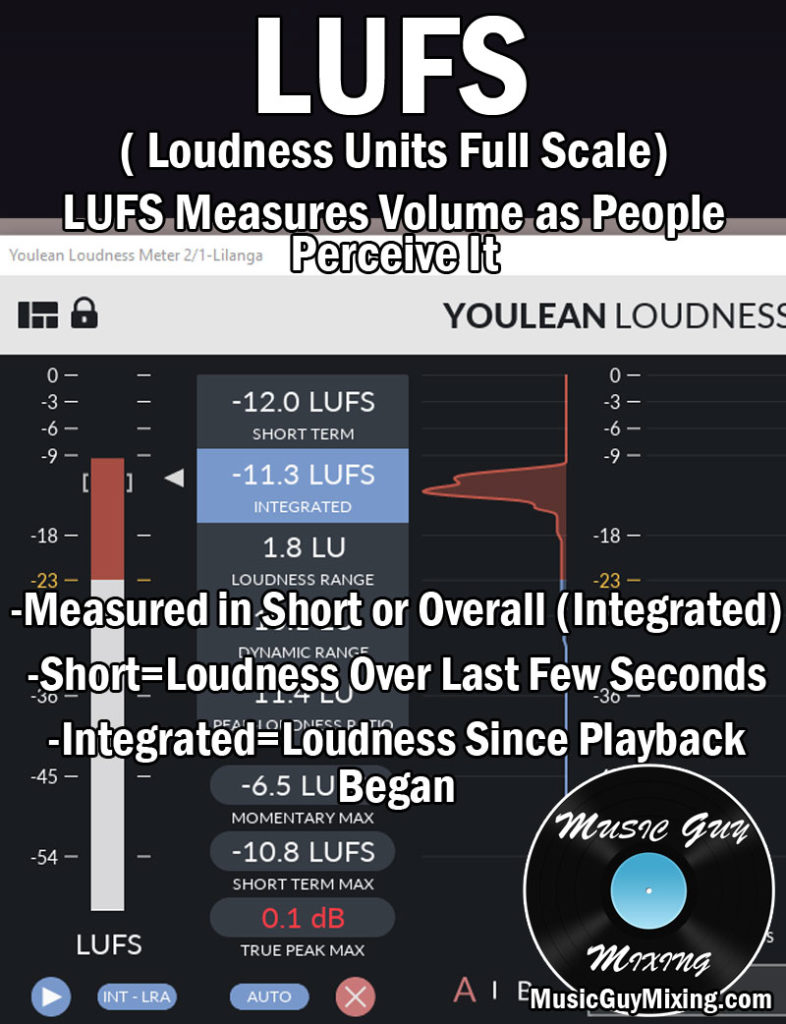Measuring the loudness of sound is critical when we’re recording or mixing music. Loudness is measured in both LUFS and dBs, and while they each have their own purpose, it can seem confusing if you don’t know the difference.
Let’s compare LUFS vs dB, what’s the difference, and when (and how) should you use each one.

What Are LUFS
Let’s begin by identifying what are LUFS.
LUFS is short for Loudness Units Full Scale. Admittedly that acronym explained doesn’t exactly better explain what LUFS are or what they’re used for.

LUFS are the measurement of loudness as perceived by us humans (Hmm why did I feel it necessary to specific US…).
It can be measured by short term or overall/integrated.
Short term is if you want to check a particular section. The overall/integrated refers to the loudness for a piece of audio as a whole or at least since playback began.
There are recommended LUFS levels to aim for depending upon what the audio is for.
For streaming, you typically want to aim around the -10 LUFS area for the overall level of your finished masters. This can vary from platform to platform, and they all normalize to a certain level, bringing your overall loudness up or down to meet that range anyway.
This is why it’s difficult to give a blanket, across the board number to aim for.
Still, because this system is directly tied to how humans interpret volume, it makes arguably the most sense of any system.
Furthermore it’s the most practical way to convey how loud a client wants something to be whether it’s in music, broadcasting, etc.
What Are DBs
dBs use a different system. Instead of working with an accepted loudness level, dBs utilize an accepted noise floor level.
0 dBSPL (decibel sound pressure level) refers to the quietest sound humans are capable of hearing. So everything above that is a measurement of how loud that sound is compared to the quietest sound we can hear.
Interesting, isn’t it?
For an approximation of how different scenarios (conversation, concert, firecrackers, etc.) rate in terms of dB measured loudness, check out this chart from the CDC on hearing loss.
In our DAW, we’re looking at dBFS (decibel full scale) where 0 dB is where clipping occurs. As such, we’re dealing in negative dBs when mixing.

And whether it’s an individual track or the sum of the entire mix, we want to keep the peak of our mix, that is the loudest point, well below 0 dB. Anything over that introduces distortion which begins to negatively affect our mix.
LUFS vs DB
To summarize LUFS vs dB, they each have their own place to measure the loudness of something.
- LUFS stands for Loudness Units Full Scale.
- This system is used to convey how humans perceived loudness.
- As such, LUFS can be a more practical system for aiming to get your music/audio in general to an agreed upon level.
- dBs can be represented in different ways, including dBSPL (decibel sound pressure level) or dBFS (decibel full scale).
- dBSPL relates to the difference between the quietest sound we can hear and the level of what’s being measured.
- dBFS is the accepted unit of loudness measurement in recording and mixing and uses 0 dB as the point of clipping in our digital audio workstations.
As you can see, both LUFS and dBs have their uses and purposes.
By the way, you can grab the LUFS plugin I use for free at https://youlean.co/youlean-loudness-meter/.
There’s a premium version, but the free model works just fine for measuring the average loudness of your track in LUFS so you can get it where it needs to be.

Pingback: LUFS Vs RMS - What's the Difference - Music Guy Mixing
Pingback: What LUFS to Master to for Spotify, Apple, and More - Music Guy Mixing
Pingback: What is Normalize Audio - Should You Normalize Audio? - Music Guy Mixing
Pingback: The Loudness War - What it is and Does it Still Matter? - Music Guy Mixing